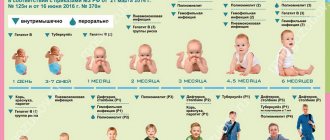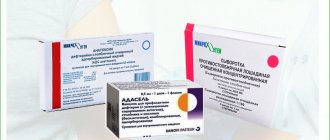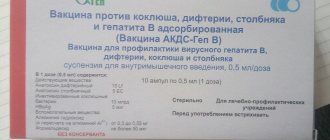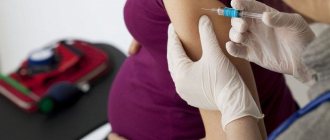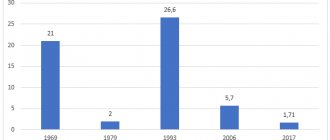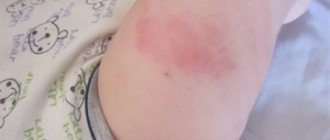If there is a disease of the mucous membrane, parents are concerned about the question: is it possible to do DPT with a runny nose? Worry about this is justified, since rhinitis reduces the child’s immune system. Vaccination during inflammation of the body can cause a number of side effects and complications. Therefore, it is important to find out the contraindications and what will happen if you do DPT with a runny nose.
The timing of vaccination is limited by time, so if the vaccination is not done on time, the child runs the risk of developing long-term rhinitis and a clear decrease in the body’s protective functions. What will happen in this case, as well as how to avoid undesirable consequences, we will find out in this material.
Is it possible to give a child the DTP vaccine if he has a runny nose?
Despite the importance of vaccination, many parents are afraid of the consequences that may arise if they vaccinate their child without understanding the issue. And that is why many are concerned about the question of whether it is possible to do DTP for a runny nose. Indeed, during a respiratory disease, the body’s strength is spent on recovery, which is why the immune system decreases. If at this moment a vaccine is introduced into an already weakened body, this can lead to a number of complications.
It is important to note that vaccination during a cold can be not only dangerous, but also useless. For the same reason: during inflammation of the mucous membrane, the body will be busy recovering, and the expected immune response will not occur. Therefore, it is important to understand what contraindications exist for vaccination.
What happens if you give DTP to a child with a runny nose: possible complications
If your child is suffering from a simple runny nose, then vaccination should not be cancelled. It is important to take into account that after vaccination the baby may have an increase in snot production. There is no need to worry about this, as this is a normal reaction of the body.
If a runny nose carries with it all the signs of an acute respiratory viral infection, then vaccination is postponed until the child has fully recovered . In addition, when examining the baby, the pediatrician will establish an accurate diagnosis, prescribe treatment, and in no case will give permission for vaccination.
Vaccination schedule
According to the approved schedule, DTP vaccination is carried out in 4 stages. Ideally, a child should be vaccinated starting at 3 months, and the next two injections should be given at intervals of 2 months. DPT revaccination should occur exactly one year after the last vaccination.
If for some reason the scheduled vaccination did not start at 3 months, then it is done later, but with an interval of 1.5 months between vaccinations. The fourth vaccination is scheduled a year after the third injection.
Features of vaccination:
- this vaccine can only be administered to children under 4 years of age;
- then you can only use a drug that does not contain a pertussis component;
- up to 6 years of age you can get the ADS vaccine, and after 6 years - ADS-M.
But in fact, it is not always possible to vaccinate on time, because children very often suffer from respiratory diseases. And sometimes a simple runny nose can delay the start of vaccination indefinitely. Therefore, the question arises whether it is worth postponing vaccination if the child is not bothered by anything other than rhinitis.
Is it possible to do DPT for a cough?
Colds are accompanied by coughing up sputum. Cough is a good reason to delay the administration of a drug containing whooping cough, but does not prevent the child from being vaccinated with ADS. It is important that the body is not weakened by the disease, otherwise complications cannot be avoided.
If the cough is residual, the immunity has managed to recover, and tests show the absence of inflammatory processes, then the attending physician has the right to carry out the planned vaccination. It is necessary to carefully monitor the child’s health so as not to miss complications.
True and false contraindications
Like all medications, the DTP vaccine has contraindications, and there are quite a lot of them when compared, for example, with the anti-influenza vaccine.
Common reasons for justified refusal to vaccinate include:
- individual intolerance to one of the components of the drug;
- state of immunodeficiency;
- diathesis, ARVI in the peak state and for some time after the disappearance of symptoms;
- neurological diseases;
- convulsions that occur without an increase in temperature (in this case, vaccination with a drug that does not contain the whooping cough component is possible).
If convulsions occur against a background of high temperature during a respiratory illness, then this cannot be considered a contraindication to vaccination.
In addition to the listed true contraindications, there are also false ones, which are mistakenly considered a reason for postponing vaccination. These include:
- enlargement of the thymus gland;
- disruption of the gastrointestinal tract, dysbacteriosis;
- atopic dermatitis;
- anemia;
- Down syndrome.
Allergic manifestations in a child are the most common reason for refusing vaccination. In addition, some believe that allergic reactions in close relatives are also considered a contraindication to vaccination. Only an allergy to the components of the drug is a serious argument against.
The opinions of domestic doctors differ regarding the possibility of vaccination during a runny nose. In most countries of the world, a mild form of acute respiratory infections, in the absence of acute inflammation, will not affect the vaccination process in any way and will not cause complications. That is, a runny nose without fever and other accompanying phenomena is not a reason to postpone DTP vaccination. But at any hint of the development of a cold, the introduction of the vaccine should be postponed.
Contraindications to vaccination
Regardless of which vaccine is administered, there are contraindications for vaccination. Diseases and conditions for which doctors do not recommend vaccinating a child:
- intolerance to the components of the vaccine;
- immunodeficiency;
- pathological abnormalities in the development of the nervous system;
- convulsions when the temperature rises.
Temporary restrictions:
- infectious diseases;
- exacerbation of diathesis.
Most experts believe that there are conditions that are unjustifiably included in the list of contraindications:
- enlargement of the thymus gland in children;
- dysbacteriosis;
- encephalopathy;
- Down syndrome;
- chronic dermatitis of an allergic nature;
- anemia.

The DTP vaccination is complex, as it contains components that contribute to the development of immunity against tetanus, diphtheria and whooping cough. Its multicomponent nature increases the risk of developing negative manifestations. Therefore, many are interested in the question: is it possible to do DPT with a runny nose or is it better to wait?
The answer to this question depends on the nature of rhinitis, as well as on the strength of the immune defense.
Reaction to the vaccine
There is a misconception that a good response to a vaccine means a complete absence of side effects. This option is also possible, but since DTP is a heavy vaccine, the body reacts to its administration by restructuring the immune system. Therefore, do not panic if your child experiences the following reactions:
- pain, swelling or redness at the injection site (swelling can reach 8 cm in diameter, but no more);
- increased body temperature;
- lethargy, apathy, loss of appetite;
- upset stomach, vomiting;
- irritability, anxiety;
- general malaise.
While such a reaction to a vaccine can occur in a completely healthy person, for a child with a cold the consequences can occur much earlier and be much more dangerous.
Sometimes a runny nose is itself a reaction to the vaccine, which indicates the presence of inflammation or malaise at the time of the injection. An experienced doctor cannot always accurately determine the presence of hidden diseases or the nature of rhinitis. Many doctors do not consider a constant runny nose to be a reason to postpone vaccination, believing that if rhinitis is not accompanied by a high temperature and cold symptoms, then DTP can be done.
It is better to postpone the administration of the vaccine until after complete recovery. After all, each child’s body is individual, and it is impossible to say with certainty what the reaction to the vaccination will be, especially if at the time of its administration there was a slight malaise. This will minimize the risks of vaccination.
Negative consequences after vaccination
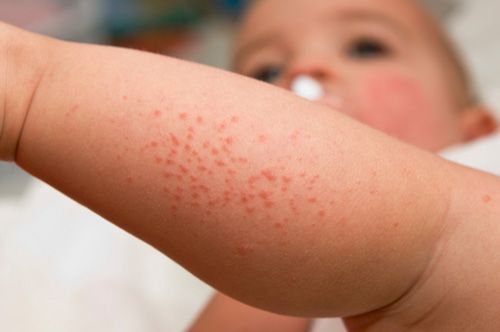
What causes complications? Undesirable consequences after vaccination can be expected for the following reasons:
- Local complications, which manifest themselves in the form of redness, swelling at the injection site, and suppuration.
- Failure to comply with contraindications. Complications can be very serious. If the baby has a congenital immunodeficiency, then the administration of live vaccines against measles or rubella can be fatal.
- Violation of the technique and rules for administering the vaccine, an increased dose of the drug was administered or the wrong method of administration was chosen.
- Low quality vaccine. Typically, all children who were administered a drug from the same batch experience almost the same complications.
- Violation of transportation and storage rules. Failure to comply with the temperature regime leads to changes in the properties of the vaccine, which affects its effectiveness and can lead to the development of allergic reactions. In serious cases, anaphylactic shock.
- Individual intolerance to the components of the vaccine. It is difficult to predict the development of complications. This reaction of the body most often leads to allergic manifestations or neurological problems.
Runny nose in a baby
A runny nose (acute rhinitis) is one of the signs of ARVI and may also be accompanied by an increase in body temperature, coughing and decreased appetite in a child. Acute rhinitis is a serious problem for infants and, especially, newborns. In this case, the infant becomes restless, refuses breast milk or formula, and sleeps poorly. The main symptom of rhinitis is the appearance of nasal discharge: initially liquid and transparent - serous, then thicker - mucous, and finally, when a bacterial infection is attached - mucopurulent. An age-related feature of young children is narrower nasal passages compared to adults, so the former’s nose becomes clogged more quickly than the latter. In addition, it is extremely difficult for a baby to breastfeed with a stuffy nose, and sometimes almost impossible. Everything is further complicated by the fact that babies are not able to blow their nose on their own. Parents in such a situation can help them both by using folk remedies and recognized medications for the treatment of acute rhinitis in children.
Remedies and methods for treating runny nose in infants
Mechanical cleaning of the mucous membrane and removal of formed crusts using cotton swabs with a limiter for infants. In any case, the child will not lie still, but despite this, it is extremely important to carry out this procedure very carefully. Damage to the mucosa will lead to infection and complications.
Moisturizing the nasal mucosa. A folk remedy such as warm mineral water is quite suitable for this purpose. Salt water will soften the crusts in the nose and make it easier to remove them mechanically. To normalize the condition of the nasal mucosa and improve its barrier function, you can also use sterile solutions of sea water with microelements sold in pharmacies, such as Salin and Aqua Maris. Such solutions are ideal means for hygiene of the nasal cavity of infants: one injection into each nostril is enough, they have no side effects and their only contraindication is an allergy to the components of the drug.
Use of nasal aspirators. Today in pharmacies and children's stores you can find a huge selection of children's nasal aspirators, from simple to electric. A simple nasal aspirator is a bulb or rubber balloon with a tip. There are different types of tips with hard, soft and wide tips depending on the age of the child. They can be taken apart and washed with soap, but should not be boiled. When using an aspirator, you need to squeeze the rubber balloon, release the air and bring it to the corresponding nostril, after first closing the other nostril, and then release it and eventually collect all the mucus from the nose. The use of such aids is extremely controversial. According to the authoritative opinion of pediatric ENT doctors, frequent and improper use of an aspirator creates all the conditions for infection and the development of otitis media. Ideally, it is better to use an aspirator if there is significant impairment of nasal breathing due to nasal secretion congestion and if other more conservative methods of treating a runny nose, described in the first two paragraphs, are ineffective. The electric nasal aspirator is practically devoid of these disadvantages, but it has an extremely high price compared to simple children's nasal aspirators.
Vasoconstrictor nasal drops. Although they are sold over the counter without a prescription, their use must be discussed with your doctor. Vasoconstrictor nasal drops contain alpha-adrenergic agonists (Nazivin, Otrivin) or sympathomimetics (Nazol Baby). These substances lead to vasoconstriction, reducing blood flow to the nasal mucosa, thereby reducing swelling and swelling. This leads to improved nasal passage and easier breathing when young children have a runny nose. According to the instructions, a 0.01% solution of oxymetazoline (the active ingredient of Nazivin) is prescribed by a doctor, 1 drop to newborn children 1 month of life and 1-2 drops to children from 1 month to a year in each nostril 2-3 times a day. It is possible to use Nazivin by applying age-appropriate drops on cotton wool and then wiping the nasal passages. The instructions for Nazol Baby, containing a 0.0125% solution of phenylephrine, indicate that it can be instilled 1 drop, but not more than every 6 hours. For infants, a 0.05% xylometazoline solution is also available in the form of nasal drops (patented name Otrivin). Infants are prescribed 1 drop in each nostril 1-2 times a day. Even after a doctor’s prescription, you should not use nasal drops for more than 5 days - the effect of longer treatment may not only be weakened, but also cause the opposite reaction - worsening a runny nose. The dosage regimen should be strictly observed and a solution with a concentration of the active substance only corresponding to the age of the child should be used. For example, Nazivin is used for up to a year with a 0.01% concentration of the active substance, and for children over 6 years of age and adults, it is used with a five times higher concentration - a 0.05% solution of oxymetazoline. In high doses, these drugs affect the functions of the heart, so poisoning with vasoconstrictor drops should be taken extremely seriously. The first signs of poisoning with vasoconstrictor drops may be: excessive drowsiness of the child, lethargy, rapid heartbeat. If you accidentally confuse children's nasal drops with your own, it is best to consult a doctor to assess the child's condition and subsequent symptomatic therapy. Thus, if you still cannot do without using drops, use them extremely carefully, strictly follow the dosage regimen and the appropriateness of the drug for the age of the child.
Every good parent, at the first sign of a child’s illness, always tries to help him. A runny nose causes unnecessary discomfort to newborns and infants. Parents are able to help their child. The choice of funds today is huge. When using them, you must be extremely delicate and careful, strictly coordinate your actions with the instructions and recommendations of the doctor, observe the age and frequency of use of the drugs, and, if necessary, seek medical help again.

